How to map the planet conquered
 Bashny.Net
Bashny.Net
A payment card today - the most popular payment instrument, though, seems to be her age comes to an end. In 2013, in the US the number of payments with credit cards exceeded the number of payments with checks, and debit cards reached the same point in 2004. The magnetic card are gradually replacing the chip cards, and plastic can all leave due to mobile payments, such as Apple Pay. < br>
Let's look at what people used to credit cards: where they came from, how to take its modern form, and why they squeezed it this font
. One of the earliest ancestors of modern payment cards - metal tokens, which in the early twentieth century department stores issued to customers to keep track of purchases. Sellers did mark medal in the accounting books in front of the name of the buyer.
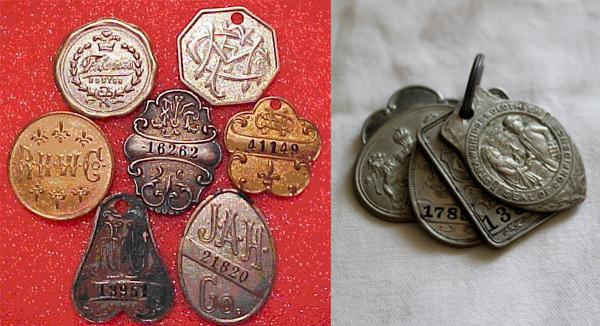
According to the accounts I had to pay: if now the default loan payment you will get calls, some hundreds of years ago, you would immediately come collector in a cart drawn by a horse, and would take away your property.
But it was only a local business, so entrepreneurs are tied to their clients. The journey of these steel plates would not have brought you good, they would not have taken anywhere. But traveling with a lot of cash - not the best idea as it is now, and a hundred years ago. This is taken care of in the 1880s, American Express Company. Because of the need to use letters of credit to get money president instructed the head of a department to develop alternatives that have become travelers' checks.
This tool is used now, traveler's checks issued in euros and dollars. They can only pay the owner, and in case of theft or loss of their reduced at American Express offices and partners.
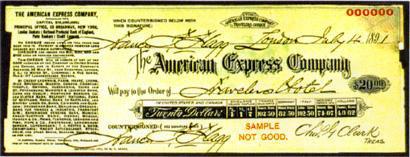
In 1920, Texaco began producing cardboard cards to their customers - so that they use them at gas stations. It soon became clear that the board is not suitable for gas stations, it is too easy to get dirty. Therefore Farrington Manufacturing Company produced steel embossed card. They helped to automate the payment process - the clerk had to do was print the data. The document, which is issued at a purchase using a credit card, call slips. For the extrusion of letters the company considered the most appropriate font Farrington 7B. It is still used for embossing cards.
In 1940-1950-ies during the "trade boom" in the US non-cash payment system to replace the beginning of the checkbooks. Getting credit cards put a specialist in consumer lending National Bank of Flatbush in Brooklyn, John C. Biggins, organized in 1946 Charge-it system: customers pay for goods receipts, the store gave the receipts to the bank and pay for goods at the buyer's expense. This chain has not changed, but its speed increased.

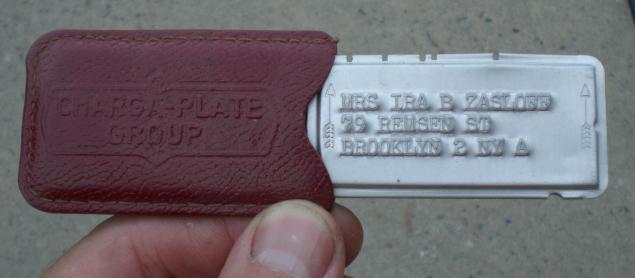
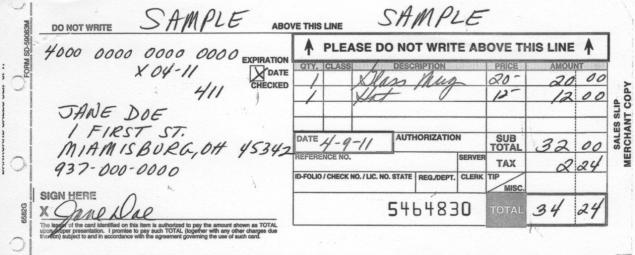
Diners ClubKompaniya Diners Club was founded in 1950, it became the first independent credit card company, which started to work with the cards mostly for payment of travel and entertainment. According to legend, it all started with a forgotten wallet at home - the company's founder in 1949, unable to pay for dinner at a restaurant. The aim of the project was the opportunity to visitors to these establishments are not limited to cash. The club gave the card, he acts as a guarantor for obligations, paying invoices, and club members receive a monthly statement and had two weeks to pay the full amount of the club.
In 1950 he issued the first 200 Diners Club credit cards. Most of them were friends of the founder of the company. The card is accepted at 14 restaurants in New York City. The cards were made of paper, on the back side - addresses and restaurants where they are received.
It looked like one of the first cards Diners Club:
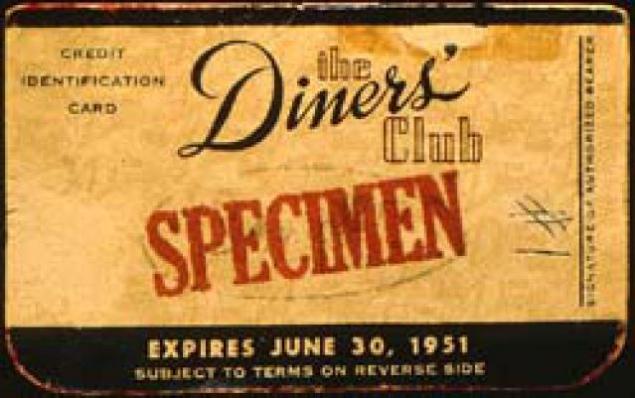
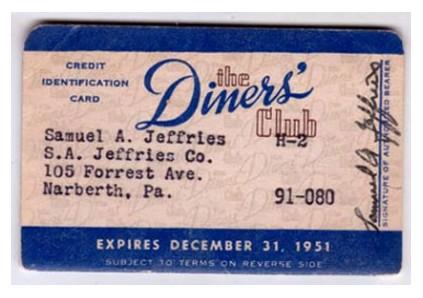
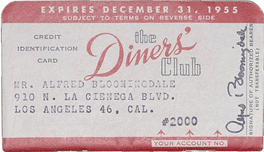
The cards were made of paper. By the end of 1950 it was already 20,000 cardholders, which could pay off in 285 restaurants. Since the mid 1950s the company entered the international market, on the American Stock Exchange, and in 1981 it bought Citibank.
In the USSR, the first credit cards began to operate in 1969, when the stores "Birch" began to take to the Diners Club payment. Since 2004, Diners Club cards in the US and Canada received the MasterCard logo, and they became possible to pay anywhere where accept cards of the system. July 1, 2008 the company Discover Financial Services acquired Diners Club International for $ 165 million.
Until 1958 year, Diners Club had no competitors - they are not physically there. Until the BankAmericard card.
VisaV 1958 the experiment in order to reduce the costs associated with payments in small business, started Bank of America. 60 thousand bank BankAmericard credit cards were sent to the city of Fresno, California. They were ready to use the card, which did not need to fill in an application to the bank. Now such carelessness would have ended in disaster, but in 1950 everything went smoothly.
The limit on the card was set to $ 500. Translated into today's prices it is more than 4 thousand dollars. These went to the bank is not instantaneous, for a loan one could not follow - in theory, it was possible to buy a huge amount of goods and escape from the police in the woods, with a car, a tent and a supply of food for twenty years.
By 1959, those cards were more than two million and twenty thousand of entrepreneurs took them for payments. These figures become more significant to mention that then when you make the purchase was made with the card data imprint on the receipt - slip. Without the convenience of terminals, computers and the Internet. Automation helps embossed data on the card.
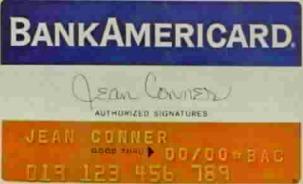

Bank of America began to provide its system to other US banks, but not all of it is arranged. Imagine that on the credit card of Alfa Bank, Sberbank written in large letters - a very strange situation. So we had to invent a new name for the system and is not associated with a particular bank.
So there was a mark "Visa" on the cards, and Bank of America gave them the company's operations National Bank Americard, specially created for this purpose. Later it was renamed Visa USA, then - in the Visa International.
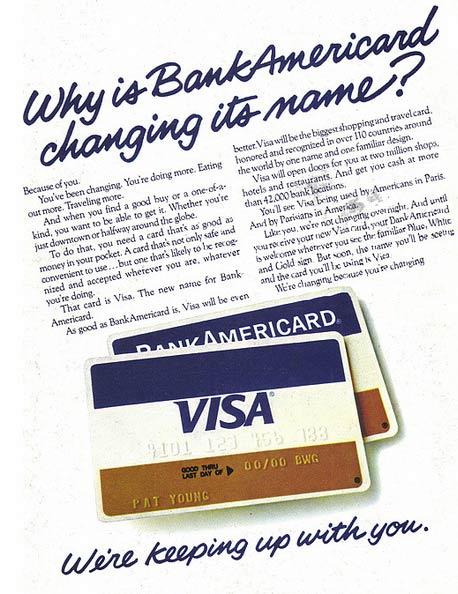
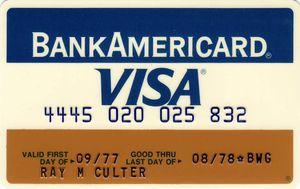
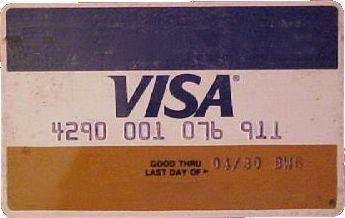
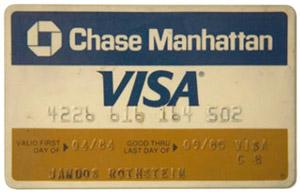
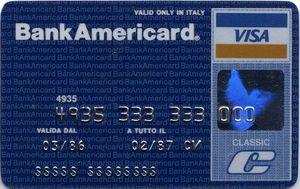

On volume of transactions for 2016 leading payment systems Visa is 56%. Behind her there is a MasterCard with 26%. China UnionPay occupies an honorable third place, with the main its turnover accounted for operations inside the country.
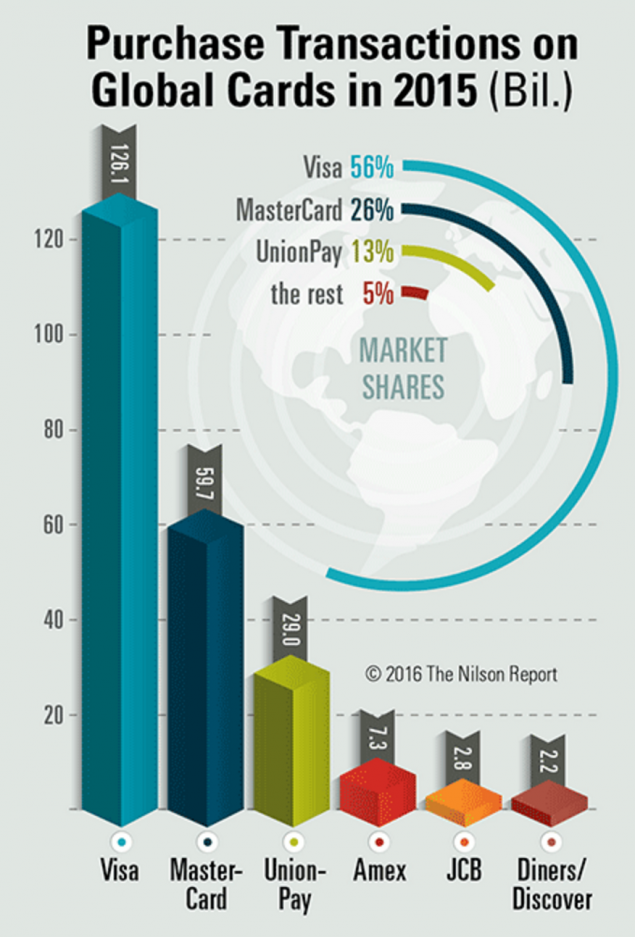
Infographics: Nilsonreport
MasterCardSistema MasterCard BankAmericard was created as a rival and was originally called Interbank. The company was founded in 1966 when several banks have agreed to form a unified system and Interbank Card Association.
In 1968, MasterCard Eurocard using the European system came to the European market - the agreement provides for the mutual acceptance of payments in the two systems.
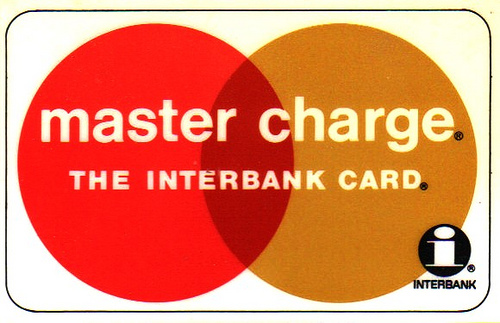
With the foundation in 1979 and the product of the association called «Master Charge: The Interbank Card», and in 1979 the system has acquired its current name - MasterCard. In 1996 the company signed a contract with AT & amp; T to create the operating infrastructure to reduce the time for processing requests. By 1998, there were ATMs that accept MasterCard in Antarctica.
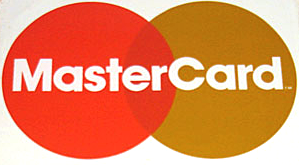
In 2014, MasterCard in collaboration with Apple enabled mobile wallet functionality in the iPhone.
How to take the first maps were MapsAbout identification numbers. The receipt in the institutions where they were received, have entered the numbers manually. First, the task simplified embossed on the map data, and later - imprinters
. The device made a slip, propechatyvaya card number on the form. So imprinters and standard forms for them are still selling. On the Banki.ru in 2010 we discussed whether further need for POS-terminal manual imprinter, which will operate when there is no connection or electricity.
The video - instruction manual imprinter
.

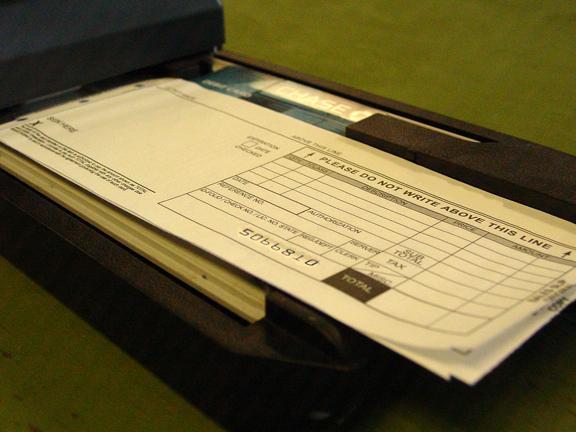
In 1960 he made the first plastic card with a magnetic strip. By a hand IBM. The goal was to develop a method of secure data storage - reliability barcodes and perforation no different. So we decided to use a magnetic medium, has already been used to store information in computers.
In the photo below - a prototype of a magnetic stripe card, made by IBM. Engineer Forrest Perry tried to glue the strip, but it exploded. He told his wife about it, and she offered to try to be fused into the plastic strip with a conventional iron. impromptu experiment was a success.
The production of magnetic stripe cards as follows: printed plastic base - both sides of the card is covered with two sheets of laminate, fixed on the surface of the magnetic strip, and placed in a thermal press, in which the sandwich is processed at a temperature of 160 degrees.
The first magnetic strip on the card has been on the front side of it.
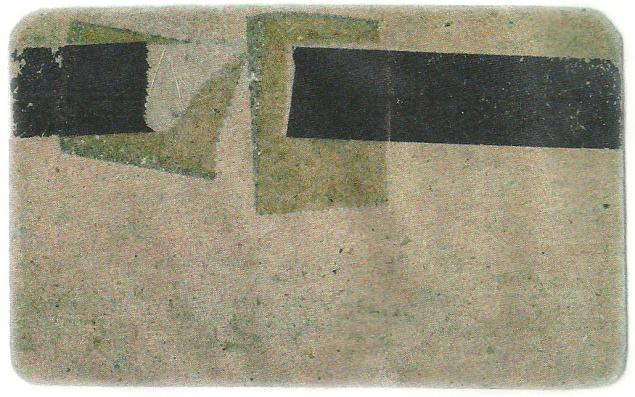
first prototype magnetic stripe cards
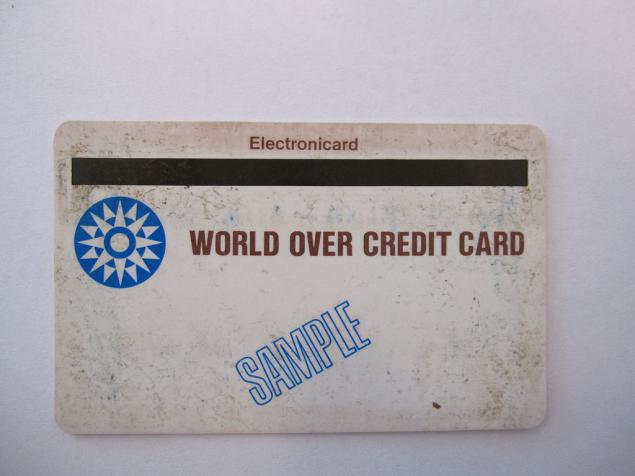
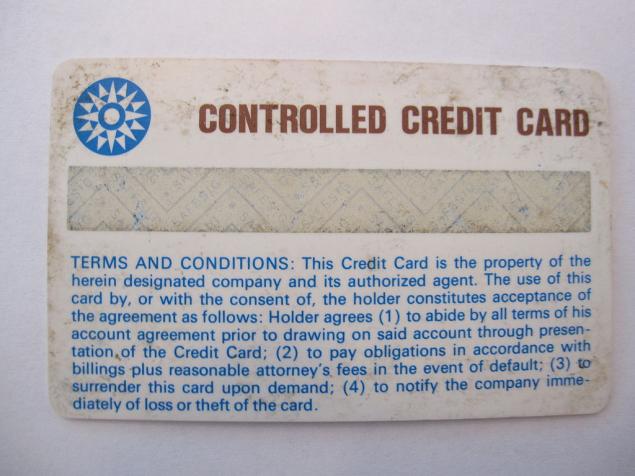
The magnetic layer of a credit card has three bars - track. Previously stored PIN on the third track for the card at ATMs without dostua network. Now only two.
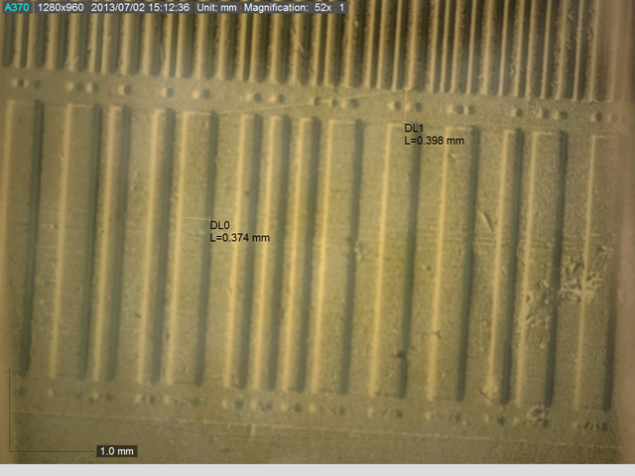
The world's first ATM appeared valid at Barclays in 1967 in north London. But he did not take credit cards and paper vouchers. At a time can be obtained no more than 10 pounds. Vending machines with chocolate bars were then commonplace, and they, as well as closed for the night bank, prompted the Scottish inventor John Sheppard Barron's, the idea of automatic receipt of money.
John Shepherd-Barron in 2005 received the Order of the British Empire for his invention, and a year later the same award was given to James Goodfellow as the creator of the PIN-Code.
The first ATMs for accepting bank cards were installed Lloyds Bank in the UK in 1972. These machines developed IBM. The development of telecommunications has allowed to create a whole network of ATMs that can use multiple banks. In Russia, the first ATMs appeared in 1991 in the World Trade Center and American express office.

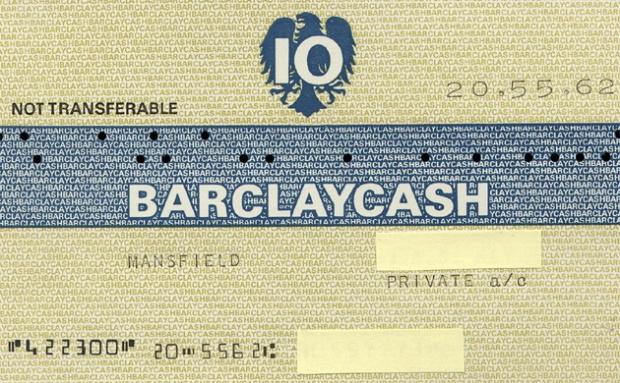
At the end of the seventies in the United States were first payment terminals for magnetic stripe cards - EFTPOS. Of course, these cards can be used and take in the shops, but only with the help of imprinters.
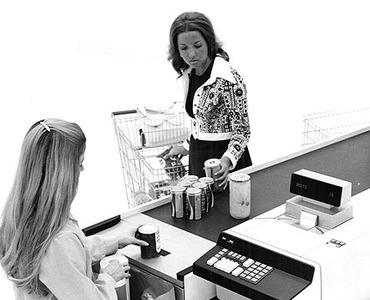
POS IBM 3663
In 1986, for the first time in the POS with support for magnetic stripe cards use touchscreen. It was branded POS ViewTouch, built on 16-bit Atari 520ST computer with 12-inch touchscreen color display Atari SC1224. The device presented engineer Eugene Mosher exhibition ComDex November 17, 1986.
The device is first placed in several restaurants in the US and Canada.
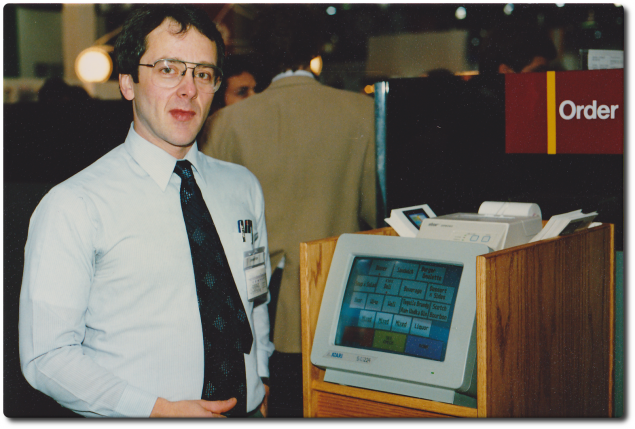
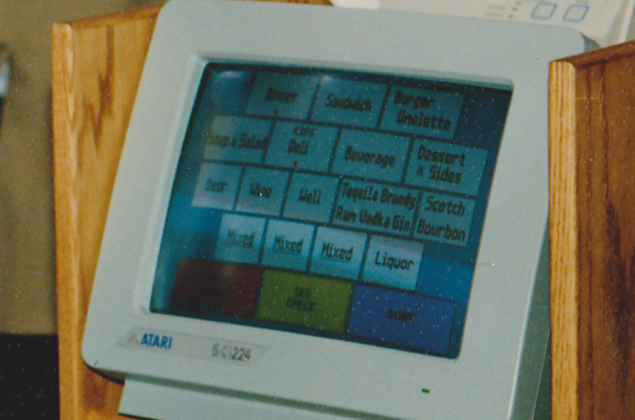
In the early 1990s in Europe have started to develop the banking smart card standards - plastic cards with an integrated chip, is very reminiscent of sim card. on technology patent was issued in 1982, and in 1983 in France started to produce chip cards for payment of telephone bills. Such cards are used in the French health care system. And it was in France in 1992, all debit cards have got microchips. In the 1990s there were SIM-card in the smart card - "full-size" SIM cards
.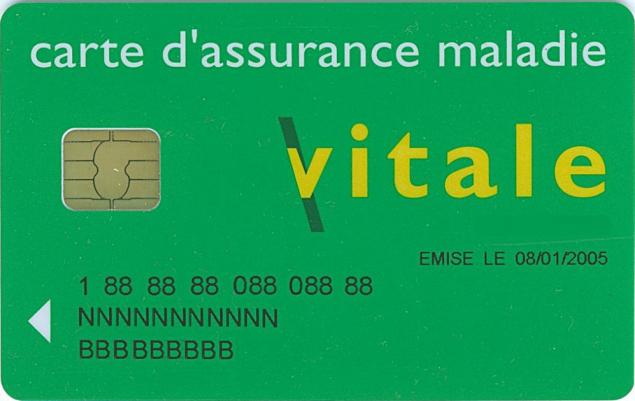
Mounted inside the RFID-chip card allows you to make contactless payment technology PayPass and PayWave. Below - Visa PayWave advertising for the Russian market
.
In 2012, MasterCard introduced the map with the keyboard and LCD screen. The microcomputer inside the card generates one-time passwords and stores the history of operations, as well as showing the account balance.
It looks like a modern terminal for receiving cards. These terminals communicate with the bank via the mobile network and can run on batteries, making them convenient, for example, to pay in restaurants. Some devices support contactless payment, but is a minority - especially in conservative US
.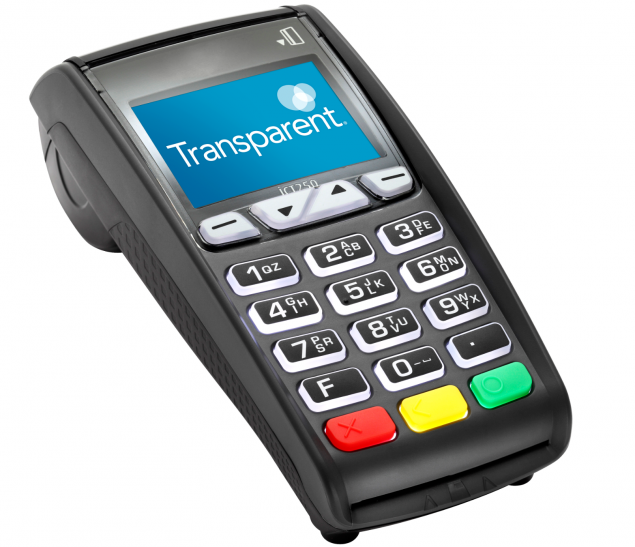
MoshennichestvaMoshennichestva credit cards began immediately after their occurrence. Savvy Americans realized that having a large credit limit, you can collect the goods, to sell some of them and go to another state or country.
The next wave of Internet commerce has been a boom in the mid-1990s. The sites were "buy" button. Criminals used the stolen card numbers and famous names - such as Mickey Mouse, Lex Luther, John Wayne, Bill Clinton. Then the system does not check the name of the payer and comparing it with the card number, and the sellers have to change it.
Availability of ATMs on every corner led to the spread of another type of fraud: to copy the card with a skimmer. The device, sometimes almost invisible, is set to the slot for receiving a plastic card. Skimmer makes a copy, but to fully enjoy it then, you must know the pin code. In this case, to the aid of a miniature video camera aimed at the keyboard. Many people do not close hand the keyboard when typing, and not all ATMs are equipped with cover plate over it. Here in the photo - an example of the ATM skimmer and installed by fraudsters camera (note the upper left corner of the ATM), as well as the pad on the keyboard, which is used instead of the camera to obtain the pin code
.
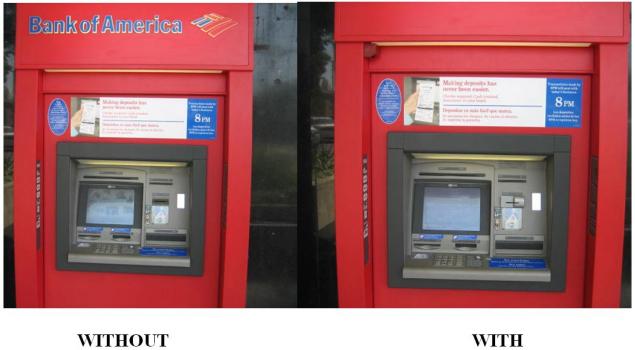
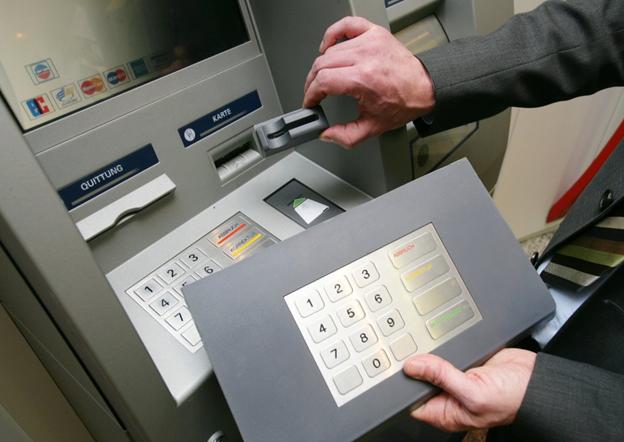
Even if you know about the skimmers and are able to detect such an overlay, we can not relax. Sometimes the doors to ATMs put the lock that opens with a card - so you can withdraw money at night, when the bank is closed. And this device is also put skimmers.
Sometimes the scammers do not bother to install skimmers on ATMs of other banks. Instead, they put ATMs. In 2015, in Udmurtia fraudsters bought decommissioned and ATMs were placed in Moscow. Money they were given, but the information is read from the magnetic tape and card PIN, and then reported on the "malfunction" and returned to the owner of the card.
Skimmers are used not only in ATMs. Technology has long gone ahead - for three seconds, the fraudster can deliver such a device to the terminal to make purchases with bank cards in a shop.
When a fraudster has data from the card and PIN-codes - it can go and spend money. As the Bulgarian Konstantin Kavrakov who took the money, including a copy of the credit card of Bill Gates. When the fraudster was arrested in 2015, when it found several credit cards Citi Visa, Standard Chartered MasterCard, Citibank MasterCard, Citi MasterCard, Citibank Visa, East-west Bank Vice, blank credit cards, checks on the transactions, and 76,000 Philippine pesos (about 1,700 USD).
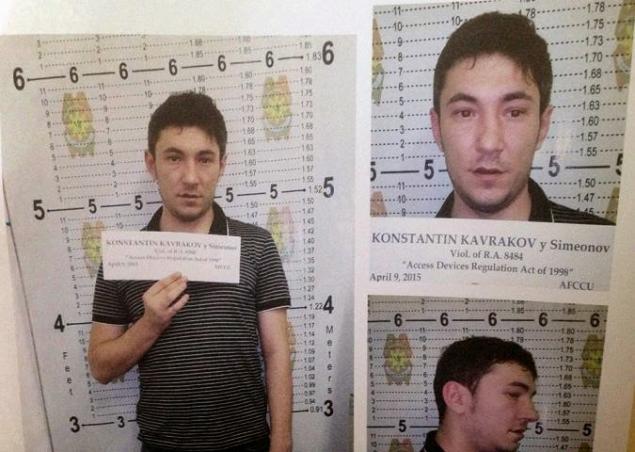
You can do without a copy of the card, the original received. To do this, the personal presence of a rogue at the ATM. The thief sets a loop in kartopriёmnik and waits. The victim receives the money, but can not pick up a card. An attacker is called to help to see the pin itself, but nothing works - and he advised to contact the bank. Pin has remained in the loop to pull out the card and withdraw all the money.

Replacement kartamMnogie people always carry with them a few bank cards, loyalty cards, skipping work, subscription to the fitness room - that is, a large number of plastic. Several projects are trying to rid us of this problem with the help of devices that store data from multiple cards simultaneously. In Russia it Cardberry. In January 2016 a start card presented in Las Vegas at CES. Already cards use beta testers in the Small Palace, chocolate and other institutions. But - in the form of a loyalty card. Credit cards only add to the plans, this raises security issues.
This project is a little earlier appeared in the United States - Coin, this card supports NFC. After a pre-order this card waiting for two years, but now its status is unclear.
Perhaps, this market will LG.
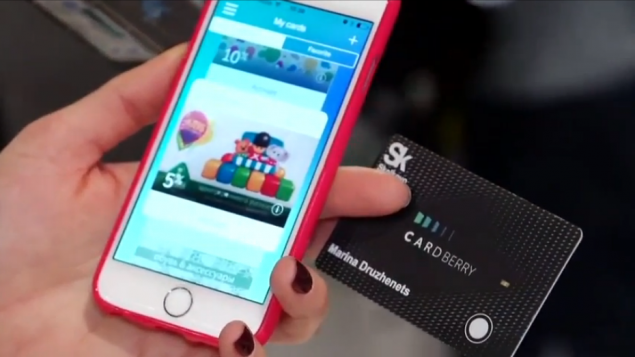
The second possible replacement of bank cards - mobile devices. Apple Pay and Android Pay uses NFC in mobile gadgets. But while Apple is looking to the future, when all payment terminals will be able to accept contactless payments, the Samsung uses technology developed LoopPay to work with older terminals, magnetic stripe readers.

Plastic cards can go into the past and thanks to the system of biometric identification of bank customers. German Gref, head of Sberbank, hopes to introduce a system of voice recognition and identification in appearance over the next two to three years. But it will work only in Russia but in other countries - only with Sberbank. In this statement the representative of VTB 24 said that the goal of the implementation of any technology associated with the abandonment of the use of cards, no.
The company, meanwhile, is testing Mastercard payment scheme by a selfie.
Source: geektimes.ru/post/277182/
Let's look at what people used to credit cards: where they came from, how to take its modern form, and why they squeezed it this font
. One of the earliest ancestors of modern payment cards - metal tokens, which in the early twentieth century department stores issued to customers to keep track of purchases. Sellers did mark medal in the accounting books in front of the name of the buyer.

According to the accounts I had to pay: if now the default loan payment you will get calls, some hundreds of years ago, you would immediately come collector in a cart drawn by a horse, and would take away your property.
But it was only a local business, so entrepreneurs are tied to their clients. The journey of these steel plates would not have brought you good, they would not have taken anywhere. But traveling with a lot of cash - not the best idea as it is now, and a hundred years ago. This is taken care of in the 1880s, American Express Company. Because of the need to use letters of credit to get money president instructed the head of a department to develop alternatives that have become travelers' checks.
This tool is used now, traveler's checks issued in euros and dollars. They can only pay the owner, and in case of theft or loss of their reduced at American Express offices and partners.

In 1920, Texaco began producing cardboard cards to their customers - so that they use them at gas stations. It soon became clear that the board is not suitable for gas stations, it is too easy to get dirty. Therefore Farrington Manufacturing Company produced steel embossed card. They helped to automate the payment process - the clerk had to do was print the data. The document, which is issued at a purchase using a credit card, call slips. For the extrusion of letters the company considered the most appropriate font Farrington 7B. It is still used for embossing cards.
In 1940-1950-ies during the "trade boom" in the US non-cash payment system to replace the beginning of the checkbooks. Getting credit cards put a specialist in consumer lending National Bank of Flatbush in Brooklyn, John C. Biggins, organized in 1946 Charge-it system: customers pay for goods receipts, the store gave the receipts to the bank and pay for goods at the buyer's expense. This chain has not changed, but its speed increased.



Diners ClubKompaniya Diners Club was founded in 1950, it became the first independent credit card company, which started to work with the cards mostly for payment of travel and entertainment. According to legend, it all started with a forgotten wallet at home - the company's founder in 1949, unable to pay for dinner at a restaurant. The aim of the project was the opportunity to visitors to these establishments are not limited to cash. The club gave the card, he acts as a guarantor for obligations, paying invoices, and club members receive a monthly statement and had two weeks to pay the full amount of the club.
In 1950 he issued the first 200 Diners Club credit cards. Most of them were friends of the founder of the company. The card is accepted at 14 restaurants in New York City. The cards were made of paper, on the back side - addresses and restaurants where they are received.
It looked like one of the first cards Diners Club:



The cards were made of paper. By the end of 1950 it was already 20,000 cardholders, which could pay off in 285 restaurants. Since the mid 1950s the company entered the international market, on the American Stock Exchange, and in 1981 it bought Citibank.
In the USSR, the first credit cards began to operate in 1969, when the stores "Birch" began to take to the Diners Club payment. Since 2004, Diners Club cards in the US and Canada received the MasterCard logo, and they became possible to pay anywhere where accept cards of the system. July 1, 2008 the company Discover Financial Services acquired Diners Club International for $ 165 million.
Until 1958 year, Diners Club had no competitors - they are not physically there. Until the BankAmericard card.
VisaV 1958 the experiment in order to reduce the costs associated with payments in small business, started Bank of America. 60 thousand bank BankAmericard credit cards were sent to the city of Fresno, California. They were ready to use the card, which did not need to fill in an application to the bank. Now such carelessness would have ended in disaster, but in 1950 everything went smoothly.
The limit on the card was set to $ 500. Translated into today's prices it is more than 4 thousand dollars. These went to the bank is not instantaneous, for a loan one could not follow - in theory, it was possible to buy a huge amount of goods and escape from the police in the woods, with a car, a tent and a supply of food for twenty years.
By 1959, those cards were more than two million and twenty thousand of entrepreneurs took them for payments. These figures become more significant to mention that then when you make the purchase was made with the card data imprint on the receipt - slip. Without the convenience of terminals, computers and the Internet. Automation helps embossed data on the card.


Bank of America began to provide its system to other US banks, but not all of it is arranged. Imagine that on the credit card of Alfa Bank, Sberbank written in large letters - a very strange situation. So we had to invent a new name for the system and is not associated with a particular bank.
So there was a mark "Visa" on the cards, and Bank of America gave them the company's operations National Bank Americard, specially created for this purpose. Later it was renamed Visa USA, then - in the Visa International.






On volume of transactions for 2016 leading payment systems Visa is 56%. Behind her there is a MasterCard with 26%. China UnionPay occupies an honorable third place, with the main its turnover accounted for operations inside the country.

Infographics: Nilsonreport
MasterCardSistema MasterCard BankAmericard was created as a rival and was originally called Interbank. The company was founded in 1966 when several banks have agreed to form a unified system and Interbank Card Association.
In 1968, MasterCard Eurocard using the European system came to the European market - the agreement provides for the mutual acceptance of payments in the two systems.

With the foundation in 1979 and the product of the association called «Master Charge: The Interbank Card», and in 1979 the system has acquired its current name - MasterCard. In 1996 the company signed a contract with AT & amp; T to create the operating infrastructure to reduce the time for processing requests. By 1998, there were ATMs that accept MasterCard in Antarctica.

In 2014, MasterCard in collaboration with Apple enabled mobile wallet functionality in the iPhone.
How to take the first maps were MapsAbout identification numbers. The receipt in the institutions where they were received, have entered the numbers manually. First, the task simplified embossed on the map data, and later - imprinters
. The device made a slip, propechatyvaya card number on the form. So imprinters and standard forms for them are still selling. On the Banki.ru in 2010 we discussed whether further need for POS-terminal manual imprinter, which will operate when there is no connection or electricity.
The video - instruction manual imprinter
.



In 1960 he made the first plastic card with a magnetic strip. By a hand IBM. The goal was to develop a method of secure data storage - reliability barcodes and perforation no different. So we decided to use a magnetic medium, has already been used to store information in computers.
In the photo below - a prototype of a magnetic stripe card, made by IBM. Engineer Forrest Perry tried to glue the strip, but it exploded. He told his wife about it, and she offered to try to be fused into the plastic strip with a conventional iron. impromptu experiment was a success.
The production of magnetic stripe cards as follows: printed plastic base - both sides of the card is covered with two sheets of laminate, fixed on the surface of the magnetic strip, and placed in a thermal press, in which the sandwich is processed at a temperature of 160 degrees.
The first magnetic strip on the card has been on the front side of it.

first prototype magnetic stripe cards


The magnetic layer of a credit card has three bars - track. Previously stored PIN on the third track for the card at ATMs without dostua network. Now only two.

The world's first ATM appeared valid at Barclays in 1967 in north London. But he did not take credit cards and paper vouchers. At a time can be obtained no more than 10 pounds. Vending machines with chocolate bars were then commonplace, and they, as well as closed for the night bank, prompted the Scottish inventor John Sheppard Barron's, the idea of automatic receipt of money.
John Shepherd-Barron in 2005 received the Order of the British Empire for his invention, and a year later the same award was given to James Goodfellow as the creator of the PIN-Code.
The first ATMs for accepting bank cards were installed Lloyds Bank in the UK in 1972. These machines developed IBM. The development of telecommunications has allowed to create a whole network of ATMs that can use multiple banks. In Russia, the first ATMs appeared in 1991 in the World Trade Center and American express office.


At the end of the seventies in the United States were first payment terminals for magnetic stripe cards - EFTPOS. Of course, these cards can be used and take in the shops, but only with the help of imprinters.

POS IBM 3663
In 1986, for the first time in the POS with support for magnetic stripe cards use touchscreen. It was branded POS ViewTouch, built on 16-bit Atari 520ST computer with 12-inch touchscreen color display Atari SC1224. The device presented engineer Eugene Mosher exhibition ComDex November 17, 1986.
The device is first placed in several restaurants in the US and Canada.


In the early 1990s in Europe have started to develop the banking smart card standards - plastic cards with an integrated chip, is very reminiscent of sim card. on technology patent was issued in 1982, and in 1983 in France started to produce chip cards for payment of telephone bills. Such cards are used in the French health care system. And it was in France in 1992, all debit cards have got microchips. In the 1990s there were SIM-card in the smart card - "full-size" SIM cards
.

Mounted inside the RFID-chip card allows you to make contactless payment technology PayPass and PayWave. Below - Visa PayWave advertising for the Russian market
.

In 2012, MasterCard introduced the map with the keyboard and LCD screen. The microcomputer inside the card generates one-time passwords and stores the history of operations, as well as showing the account balance.
It looks like a modern terminal for receiving cards. These terminals communicate with the bank via the mobile network and can run on batteries, making them convenient, for example, to pay in restaurants. Some devices support contactless payment, but is a minority - especially in conservative US
.

MoshennichestvaMoshennichestva credit cards began immediately after their occurrence. Savvy Americans realized that having a large credit limit, you can collect the goods, to sell some of them and go to another state or country.
The next wave of Internet commerce has been a boom in the mid-1990s. The sites were "buy" button. Criminals used the stolen card numbers and famous names - such as Mickey Mouse, Lex Luther, John Wayne, Bill Clinton. Then the system does not check the name of the payer and comparing it with the card number, and the sellers have to change it.
Availability of ATMs on every corner led to the spread of another type of fraud: to copy the card with a skimmer. The device, sometimes almost invisible, is set to the slot for receiving a plastic card. Skimmer makes a copy, but to fully enjoy it then, you must know the pin code. In this case, to the aid of a miniature video camera aimed at the keyboard. Many people do not close hand the keyboard when typing, and not all ATMs are equipped with cover plate over it. Here in the photo - an example of the ATM skimmer and installed by fraudsters camera (note the upper left corner of the ATM), as well as the pad on the keyboard, which is used instead of the camera to obtain the pin code
.



Even if you know about the skimmers and are able to detect such an overlay, we can not relax. Sometimes the doors to ATMs put the lock that opens with a card - so you can withdraw money at night, when the bank is closed. And this device is also put skimmers.
Sometimes the scammers do not bother to install skimmers on ATMs of other banks. Instead, they put ATMs. In 2015, in Udmurtia fraudsters bought decommissioned and ATMs were placed in Moscow. Money they were given, but the information is read from the magnetic tape and card PIN, and then reported on the "malfunction" and returned to the owner of the card.
Skimmers are used not only in ATMs. Technology has long gone ahead - for three seconds, the fraudster can deliver such a device to the terminal to make purchases with bank cards in a shop.
When a fraudster has data from the card and PIN-codes - it can go and spend money. As the Bulgarian Konstantin Kavrakov who took the money, including a copy of the credit card of Bill Gates. When the fraudster was arrested in 2015, when it found several credit cards Citi Visa, Standard Chartered MasterCard, Citibank MasterCard, Citi MasterCard, Citibank Visa, East-west Bank Vice, blank credit cards, checks on the transactions, and 76,000 Philippine pesos (about 1,700 USD).

You can do without a copy of the card, the original received. To do this, the personal presence of a rogue at the ATM. The thief sets a loop in kartopriёmnik and waits. The victim receives the money, but can not pick up a card. An attacker is called to help to see the pin itself, but nothing works - and he advised to contact the bank. Pin has remained in the loop to pull out the card and withdraw all the money.

Replacement kartamMnogie people always carry with them a few bank cards, loyalty cards, skipping work, subscription to the fitness room - that is, a large number of plastic. Several projects are trying to rid us of this problem with the help of devices that store data from multiple cards simultaneously. In Russia it Cardberry. In January 2016 a start card presented in Las Vegas at CES. Already cards use beta testers in the Small Palace, chocolate and other institutions. But - in the form of a loyalty card. Credit cards only add to the plans, this raises security issues.
This project is a little earlier appeared in the United States - Coin, this card supports NFC. After a pre-order this card waiting for two years, but now its status is unclear.
Perhaps, this market will LG.

The second possible replacement of bank cards - mobile devices. Apple Pay and Android Pay uses NFC in mobile gadgets. But while Apple is looking to the future, when all payment terminals will be able to accept contactless payments, the Samsung uses technology developed LoopPay to work with older terminals, magnetic stripe readers.

Plastic cards can go into the past and thanks to the system of biometric identification of bank customers. German Gref, head of Sberbank, hopes to introduce a system of voice recognition and identification in appearance over the next two to three years. But it will work only in Russia but in other countries - only with Sberbank. In this statement the representative of VTB 24 said that the goal of the implementation of any technology associated with the abandonment of the use of cards, no.
The company, meanwhile, is testing Mastercard payment scheme by a selfie.
Source: geektimes.ru/post/277182/
Tags
See also
TeleMoney.ru - advantageous payment system.
Street fashion in Europe and the US
MasterCard will offer its customers online payment cards
Yellow taxi in New York.
Educational program on the map projection with pictures
From the series "How to do» | Books from Tver
Yakutian diamonds - they are mined?
Installation of air conditioning in pictures
Mars - the red planet, not only
















